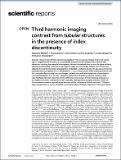Files in this item
Third harmonic imaging contrast from tubular structures in the presence of index discontinuity
Item metadata
| dc.contributor.author | Morizet, Joséphine | |
| dc.contributor.author | Olivier, Nicolas | |
| dc.contributor.author | Mahou, Pierre | |
| dc.contributor.author | Boutillon, Arthur | |
| dc.contributor.author | Stringari, Chiara | |
| dc.contributor.author | Beaurepaire, Emmanuel | |
| dc.date.accessioned | 2023-05-17T12:30:05Z | |
| dc.date.available | 2023-05-17T12:30:05Z | |
| dc.date.issued | 2023-05-15 | |
| dc.identifier | 286141612 | |
| dc.identifier | 295ad47f-df7e-47be-8fee-cc42b38a36d6 | |
| dc.identifier | 85159423928 | |
| dc.identifier.citation | Morizet , J , Olivier , N , Mahou , P , Boutillon , A , Stringari , C & Beaurepaire , E 2023 , ' Third harmonic imaging contrast from tubular structures in the presence of index discontinuity ' , Scientific Reports , vol. 13 , 7850 . https://doi.org/10.1038/s41598-023-34528-7 | en |
| dc.identifier.issn | 2045-2322 | |
| dc.identifier.other | Jisc: 1084051 | |
| dc.identifier.other | publisher-id: s41598-023-34528-7 | |
| dc.identifier.other | manuscript: 34528 | |
| dc.identifier.uri | https://hdl.handle.net/10023/27634 | |
| dc.description | Funding: Agence Nationale de la Recherche (ANR) (ANR-EQPX-0029, ANR-10-INBS-04, ANR-15-CE11-0012). | en |
| dc.description.abstract | Accurate interpretation of third harmonic generation (THG) microscopy images in terms of sample optical properties and microstructure is generally hampered by the presence of excitation field distortions resulting from sample heterogeneity. Numerical methods that account for these artifacts need to be established. In this work, we experimentally and numerically analyze the THG contrast obtained from stretched hollow glass pipettes embedded in different liquids. We also characterize the nonlinear optical properties of 2,2′-thiodiethanol (TDE), a water-soluble index-matching medium. We find that index discontinuity not only changes the level and modulation amplitude of polarization-resolved THG signals, but can even change the polarization direction producing maximum THG near interfaces. We then show that a finite-difference time-domain (FDTD) modeling strategy can accurately account for contrast observed in optically heterogeneous samples, whereas reference Fourier-based numerical approaches are accurate only in the absence of index mismatch. This work opens perspectives for interpreting THG microscopy images of tubular objects and other geometries. | |
| dc.format.extent | 11 | |
| dc.format.extent | 4723582 | |
| dc.language.iso | eng | |
| dc.relation.ispartof | Scientific Reports | en |
| dc.subject | QC Physics | en |
| dc.subject | QH301 Biology | en |
| dc.subject | 3rd-DAS | en |
| dc.subject | MCC | en |
| dc.subject.lcc | QC | en |
| dc.subject.lcc | QH301 | en |
| dc.title | Third harmonic imaging contrast from tubular structures in the presence of index discontinuity | en |
| dc.type | Journal article | en |
| dc.contributor.institution | University of St Andrews. School of Physics and Astronomy | en |
| dc.identifier.doi | 10.1038/s41598-023-34528-7 | |
| dc.description.status | Peer reviewed | en |
This item appears in the following Collection(s)
Items in the St Andrews Research Repository are protected by copyright, with all rights reserved, unless otherwise indicated.

